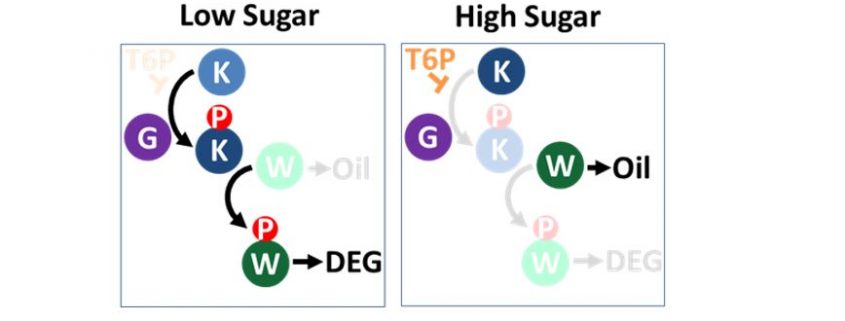Ironing Out the Wrinkles in Fatty Acid Synthesis
Zhai et al. show that Trehalose 6-phosphate positively regulates fatty acid synthesis by stabilizing WRINKLED1. Plant Cell. https://doi.org/10.1105/tpc.18.00521
Background: In plants, oil synthesis is under the control of an “on switch” or transcription factor called WRINKLED1, that binds to DNA in the regulatory regions attached to approximately 20 genes that code for enzymes involved in oil synthesis. Cellular levels of WRINKLED1 are tightly controlled to couple the availability of photosynthetically fixed sugars to the heavy metabolic demands of oil synthesis. We previously showed that under conditions of low cellular sugar, SnRK1 adds phosphate groups to WRINKLED1, marking it for rapid and selective protein degradation. This process turns down fatty acid synthesis when cellular resources are limiting. When resources, e.g., sugar, are abundant, SnRK1 activity is turned down and WRINKLED1 is stabilized, allowing more oil synthesis.
Question: The phosphorylated disaccharide trehalose 6-phosphate (T6P), a signal of cellular sugar status, is reported to be a strong inhibitor of SnRK1, so we tested whether T6P could stabilize WRINKLED1 and increase oil synthesis.
Findings: We used a new technique known as thermophoresis to evaluate the binding strength of proteins with other proteins or small molecules to show that T6P binds directly to KIN10, the catalytic subunit of SnRK1. A protein kinase called GRIK1 is responsible for adding a phosphate group to KIN10, which activates it. We again used thermophoresis to show that when KIN10 binds T6P, its binding to GRIK1 is weakened by 3.6-fold, reducing its activation. Using a mixture of purified GRIK1 and KIN10, we showed that adding T6P reduced KIN10 activation and activity with a target peptide. Direct feeding of T6P to Brassica cell cultures confirmed these findings. Further tests using extracts of wild-type and grik Arabidopsis mutants confirmed the GRIK1 dependence of T6P inhibition of SnRK1. This work identifies GRIK1 as an intermediate in the T6P-dependent inhibition of SnRK1 phosphorylation activity.
Next steps: Now that we know T6P binds to KIN10, weakening its interaction with GRIK1, we will identify structural details of the interactions to understand the mechanism of T6P control of metabolism. Knowing the mechanism will enable us to design KIN10 mutants with decreased sensitivity to sugar signals and allow us to shift photosynthetically fixed carbon towards oil synthesis.
Zhiyang Zhai, Jantana Keereetaweep, Hui Liu, Regina Feil, John E. Lunn, John Shanklin. (2018). Trehalose 6-Phosphate Positively Regulates Fatty Acid Synthesis by Stabilizing WRINKLED1. Plant Cell 30: 2616-2627; DOI: https://doi.org/10.1105/tpc.18.00521.




